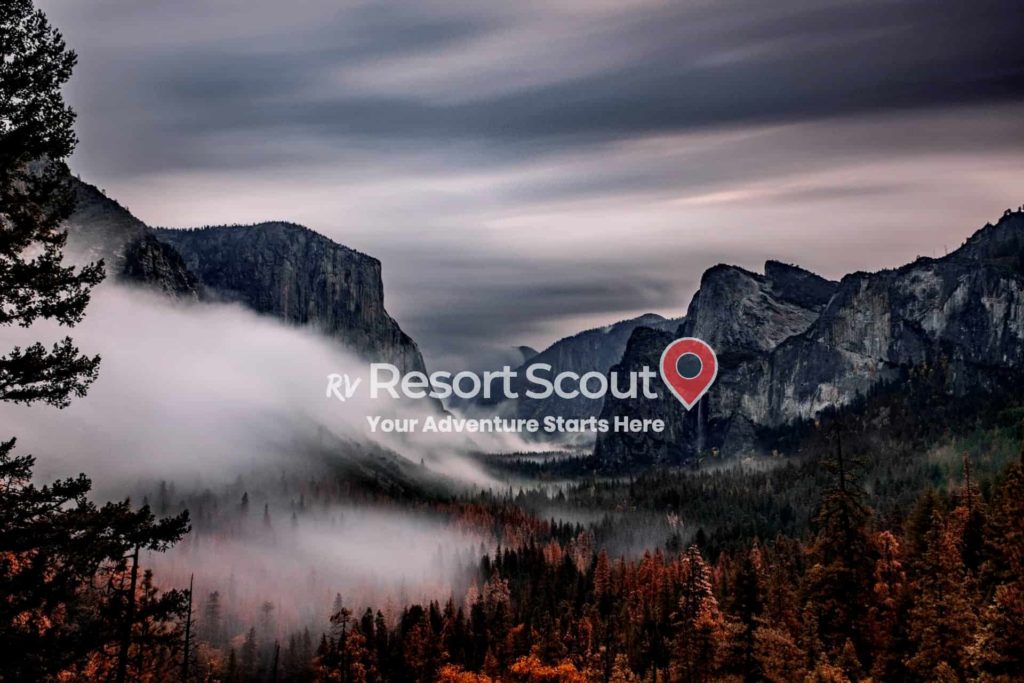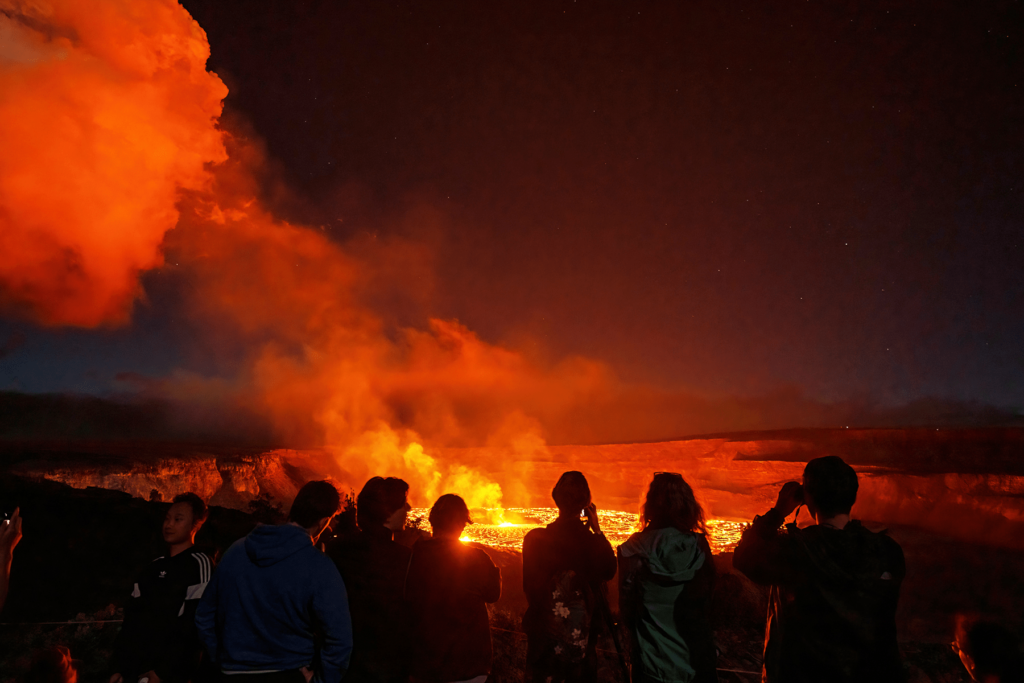
The Ultimate Guide: Hawaiʻi Volcanoes National Park

Hawaiʻi Volcanoes National Park is a must-see destination on the Big Island of Hawaiʻi. This park is home to two of the most active volcanoes in the world: Kīlauea and Mauna Loa. Visitors can explore a variety of ecosystems, including rainforests, lava fields, and grasslands, and experience the power of nature up close. With a rich cultural history and a range of accommodations and activities available, Hawaiʻi Volcanoes Park is a must-see for any traveler.
For a condensed view of the park feel free to check out rvResortScouts Hawai’i Volcanoes National Park Information listing.
Park History / General Overview
Hawaiʻi Volcanoes National Park has a long and fascinating history. In 1916, the National Park Service established the park and initially designated it as a National Monument. Then, the National Park Service upgraded it to a National Park in 1960.
The park is home to two of the most active volcanoes in the world: Kīlauea and Mauna Loa. Kīlauea is one of the world’s most active volcanoes and has been erupting nearly continuously since 1983. Scientists estimate that Mauna Loa is the largest active volcano on earth, with a volume of over 18,000 cubic miles.
In addition to the volcanoes, the park is home to a diverse array of ecosystems. They include rainforests, lava fields, and grasslands. The park is also home to a number of rare and endangered species. Two of the more well known are the Hawaiian hawk and the Hawaiian hoary bat.
The park has a rich cultural history, with many of the park’s sites and trails having significant cultural and spiritual significance to the native Hawaiian people. The park also has a number of cultural programs and events throughout the year, giving visitors the opportunity to learn more about the park’s history and culture.
Getting Oriented Within Hawaiʻi Volcanoes National Park
When visiting Hawaiʻi Volcanoes Park, it’s important to get orientated, so you can make the most of your visit. The park is located on the Big Island of Hawaiʻi, in the southeast region of the island. Divided into the Kīlauea District and the Mauna Loa District, the area covers over 330,000 acres.
The Kīlauea District is home to the park’s main entrance and the popular Kīlauea Visitor Center. The visitor center is a great place to start your visit, with exhibits, a film about the park, and a gift shop. From the visitor center, you can access a number of trails, including the Kīlauea Iki Trail and the Crater Rim Trail.
The Mauna Loa District is located in the northwest corner of the park. It is home to the Mauna Loa Lookout, a popular spot for sunset views. The district is also home to the Mauna Loa Summit Trail, a challenging 19-mile roundtrip hike to the summit of Mauna Loa.
It’s a good idea to familiarize yourself with the park’s map and plan your visit in advance. This will help you make the most of your time in the park and ensure you don’t miss any of the highlights. Additionally, you can also visit the park’s website or social media accounts for updates and information about the latest conditions and events.
Essentials
To get to the park, you’ll need a car. There is no public transportation to Hawaiʻi Volcanoes National Park, so the best way to get there is by car. The park is located just off Highway 11, about an hour drive from Hilo.
Once you arrive at the park, you’ll need to pay the entrance fee. The fee is $30 per car, or you can purchase an annual pass for $55. This fee helps to maintain and improve the park, so it’s a good investment.
The park has several visitor centers where you can learn more about the park’s geology, flora, and fauna. The Kīlauea Visitor Center is the park’s main visitor center and is a great place to start your visit. Here you’ll find exhibits, a film about the park, and a gift shop.
There are also a number of facilities and services available to visitors, including restrooms, picnic areas, and water stations. These facilities are scattered throughout the park. This means it’s a good idea to bring a map and plan your route in advance.
Thing You Need to Know When Visiting Hawaiʻi Volcanoes National Park
When visiting, there are a few things you should know to help you have a safe and enjoyable visit.
First, the park is home to two active volcanoes, so there is a risk of volcanic eruptions and earthquakes. The park has an emergency evacuation plan in place, and visitors are encouraged to stay informed about the latest conditions by checking the park’s website or social media accounts.
The park’s weather is notoriously unpredictable. The park can experience a range of weather conditions, including sunshine, rain, and high winds. It’s important to bring appropriate clothing and gear, including sunscreen, a hat, and rain gear.
Another thing to know is that the park has a number of rules and regulations that you need to follow. These include staying on marked trails, respecting wildlife, and not littering. By following the rules, you’ll help to preserve the park’s natural beauty and ensure a safe and enjoyable visit for everyone.
Best Hikes
Hawaiʻi Volcanoes National Park has a number of excellent hikes that offer stunning views and the chance to see a variety of plants and animals. Here are five of the best hikes in the park:
- Kīlauea Iki Trail: This 4-mile roundtrip hike takes you through a rainforest and across the Kīlauea Iki crater. A massive eruption in 1959 formed the crater. The trail offers beautiful views of the crater and the surrounding landscape.
- Crater Rim Trail: This 11-mile loop trail takes you around the rim of Kīlauea crater, with breathtaking views of the caldera and the surrounding landscape. The trail is relatively easy and is suitable for hikers of all skill levels.
- Mauna Loa Summit Trail: This challenging 19-mile roundtrip hike takes you to the summit of Mauna Loa, the world’s largest active volcano. The trail is strenuous and on the longer side. Only experienced hikers should tackle this trail.
- Halemaʻumaʻu Trail: This short, easy hike takes you to the Halemaʻumaʻu crater, where you can see steam vents and lava lakes. The trail is wheelchair accessible and is a great option for visitors of all ages.
- Kau Desert Trail: This 2.5-mile roundtrip hike takes you through the park’s unique desert landscape, with views of the Mauna Loa and Kīlauea volcanoes. The trail is relatively easy and is suitable for hikers of all skill levels.
When planning your hikes, it’s important to be prepared and follow safety guidelines. This includes wearing appropriate footwear, carrying plenty of water, and being mindful of any safety warnings or alerts.

Accommodations
There are several accommodation options available near Hawaiʻi Volcanoes National Park, offering something for every budget and preference.
The park has two campgrounds: Namakani Paio Campground and Kulanaokuaiki Campground. Both campgrounds have restrooms and water stations, but there are no showers or electricity. Campsites are available on a first-come, first-served basis and cost $15 per night.
Backcountry camping is also allowed in the park, but you’ll need to get a permit from the park’s backcountry office. Backcountry camping is allowed in designated areas only, and you must follow the park’s Leave No Trace principles.
In addition to camping, there are several hotels and vacation rentals located near the park. These offer a range of accommodation options, including bed and breakfasts, hotels, and vacation rentals. Many of these accommodations offer additional amenities, such as swimming pools, restaurants, and fitness centers.
No matter what type of accommodation you choose, it’s important to book in advance, especially during peak season. This will help to ensure you have a place to stay and can fully enjoy your visit to the park.
Safety Within Hawaiʻi Volcanoes National Park
Safety is an important consideration when visiting the national park. The park is home to two active volcanoes, so there is a risk of volcanic eruptions and earthquakes. It’s important to stay informed about the latest conditions by checking the park’s website or social media accounts.
In addition to volcanic eruptions and earthquakes, there are a number of other potential hazards to be aware of in the park. These include slippery trails, high winds, and lightning. It’s important to be prepared and follow safety guidelines to minimize the risk of injury.
Here are some tips to help you stay safe while visiting Hawaiʻi Volcanoes National Park:
- Stay on marked trails: It’s important to stay on marked trails to avoid getting lost or encountering any hazards.
- Wear appropriate footwear: Hiking boots or sturdy shoes with good traction are essential for hiking in the park.
- Carry plenty of water: It’s important to stay hydrated, especially in the hot and humid weather. Bring at least one liter of water per person for each hour of hiking.
- Be aware of your surroundings: Keep an eye out for any hazards, such as slippery rocks or unstable ground, and take necessary precautions.
- Follow any safety warnings or alerts: If there are any safety warnings or alerts in the park, be sure to follow them to ensure your safety.
By following these safety guidelines, you’ll help to ensure a safe and enjoyable visit to Hawaiʻi Volcanoes National Park. So, it is always better to be safe than sorry.
What’s in the Surronding Area?
There are several interesting attractions located near the park that are worth a visit. These include:
- Hawaiʻi Tropical Botanical Garden: Located just a short drive from the park, this beautiful garden features a variety of tropical plants and flowers. The garden is a great place to relax and enjoy the beauty of nature.
- Mauna Loa Macadamia Nut Corporation: This popular attraction is located just outside the park and offers tours of the macadamia nut farm. You can learn about the process of growing and harvesting macadamia nuts and even try some samples.
- Hilo: The town of Hilo is located about an hour’s drive from the park and is home to a number of museums, art galleries, and restaurants. Hilo is also home to the beautiful Liliuokalani Gardens, a peaceful and picturesque spot to relax and enjoy the beauty of nature.
- Beach parks: The Big Island has a number of beautiful beach parks that are worth a visit. These include Hapuna Beach State Park, Kaunaʻoa Beach, and Spencer Beach Park.
There are many other attractions located near the park, so there is something for everyone.
Hawai’i Volcanoes National Park Wrap Up
In conclusion, Hawaiʻi Volcanoes National Park is a truly unique and breathtaking destination. With its stunning landscapes, active volcanoes, and diverse array of plants and animals, it’s an unforgettable place to visit. Whether you’re interested in hiking, camping, or just taking in the views, there’s something for everyone in Hawai’i.
If you’re planning a visit to the park, be sure to check out the National Park Service’s page on Hawaiʻi Volcanoes National Park for more information. The page has a wealth of information, including details on park history, rules and regulations, and things to do. It’s a great resource to help you plan your visit and make the most of your time in the park.
So, don’t miss the chance to visit this amazing place and make your trip an unforgettable experience.